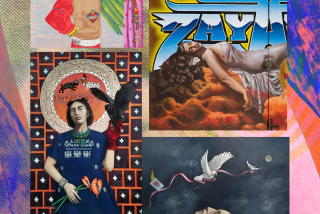Kaleidoscope’s Cultural Balancing Act : Dance: The showcase of Southern California talent broadens its base with ethnic programs beginning tonight at Cal State L.A.
- Share via
Dance Kaleidoscope, the annual showcase of Southern California talent, hasn’t always been as culturally varied as some would like. But things are opening up now.
“There may have been a perception that (Kaleidoscope) was primarily modern dance,” says director Don Hewitt of the festival, a pet project he revived three years ago after a three-year dormancy. “But now I think we have successfully broken the barrier between all kinds of dance and communities.
“We’ve always tried to do a balance of groups, but right here in East L.A., we’re in the middle of the Asian and Latino communities, so it’s seemed a particularly suitable and exciting inclusion,” says Hewitt, referring to the presence of artists from both communities on this year’s program. “It’s by nature a multicultural event, and the (ethnic) program has been one of our most successful evenings.”
Program A of Dance Kaleidoscope, which plays tonight and Saturday at the State Playhouse at Cal State L.A., is, in Hewitt’s words, “world cultural, with a focus on Hispanic.” L.A.-area dancers Juan Talavera and Roberto Amaral will bring their Spanish dance companies, and Yaelisa, a soloist from San Diego, will also be on the bill. They will be joined by four other companies, all of whom specialize in international dance traditions. (Two different programs of ballet, modern and jazz dance will be presented beginning Sunday and continuing through July 28.)
While last year’s Kaleidoscope featured an unprecedented number of Mexican folklorico artists, this year there is an emphasis on Flamenco and classical Spanish dance.
In order to bring this about, Hewitt and dancer Lola Montes, who sits on the festival’s review panel, have had to make a concerted outreach effort.
Based on Dance Kaleidoscope’s content during the early ‘80s--before the festival was reborn at Cal State L.A.--many choreographers were under the impression that the festival wasn’t interested in ethnic dance.
That led to a difficulty in getting diverse talent to try out. “One reason we didn’t have more collaboration from the Hispanic community was the panel process (that required) people to audition,” says Montes, who now helps make the programming choices. “I felt we didn’t have enough participation, so I made that my mission.”
The festival now boasts a multicultural review panel, and the number of auditioning acts has increased dramatically--with many groups and soloists from a variety of disciplines--since last year.
Amaral, whom Hewitt says he’s been after to audition “for a long time,” welcomes the opportunity. “They’ve been open to ethnic dance, but there are few opportunities like Kaleidoscope that can give (an) opportunity to showcase,” says the dancer, who returned to California from Spain 13 years ago.
The problem, in Amaral’s eyes, is that the situation for artists like himself is still a far cry from the days of plenty back in the ‘70s and early ‘80s.
“There seemed to be a lot more work for ethnic dance companies back then, more presenters and producers who were willing to back it,” says Amaral. “Now, we have to do it ourselves.”
Talavera, who, like Amaral, teaches to support his dance, agrees that the opportunities are scarce. “Modern (dance) gets a lot of exposure, and ballet. But Spanish or Mexican is way down there,” says the East L.A. native.
Major venues compound the problems by relying on the same out-of-town artists. “The general circuit always uses a certain five companies, the same ones they have been for the past 20 years,” says Talavera. “There are very qualified artists here in L.A., but you end up working Olvera Street or at El Cid. Presenters are scared to take a chance on new people. So we have to do festivals.”
Which is where Dance Kaleidoscope comes in. “The word has gotten out that it’s a place to be seen and to build your audiences,” says Hewitt, who is on the faculty at Cal State L.A. and has been teaching dance in the area for 30 years. “Quite a few groups have gotten jobs from being here.”
Talavera, who has performed at Kaleidoscope before, agrees. “People say you have to get a grant, but I’m not schooled in any of that,” he says. “I’ve been lucky in that I break even most of the time. Things like Kaleidoscope help by exposing your name, and that’s why you do it.”
There is, of course, also the benefit of artistic exchange, which increases as the Kaleidoscope programs become more diverse. “When you come to see one thing, you end up liking something else,” says Hewitt. “It goes well beyond language. That’s the mission of the arts.”
More to Read
The biggest entertainment stories
Get our big stories about Hollywood, film, television, music, arts, culture and more right in your inbox as soon as they publish.
You may occasionally receive promotional content from the Los Angeles Times.










